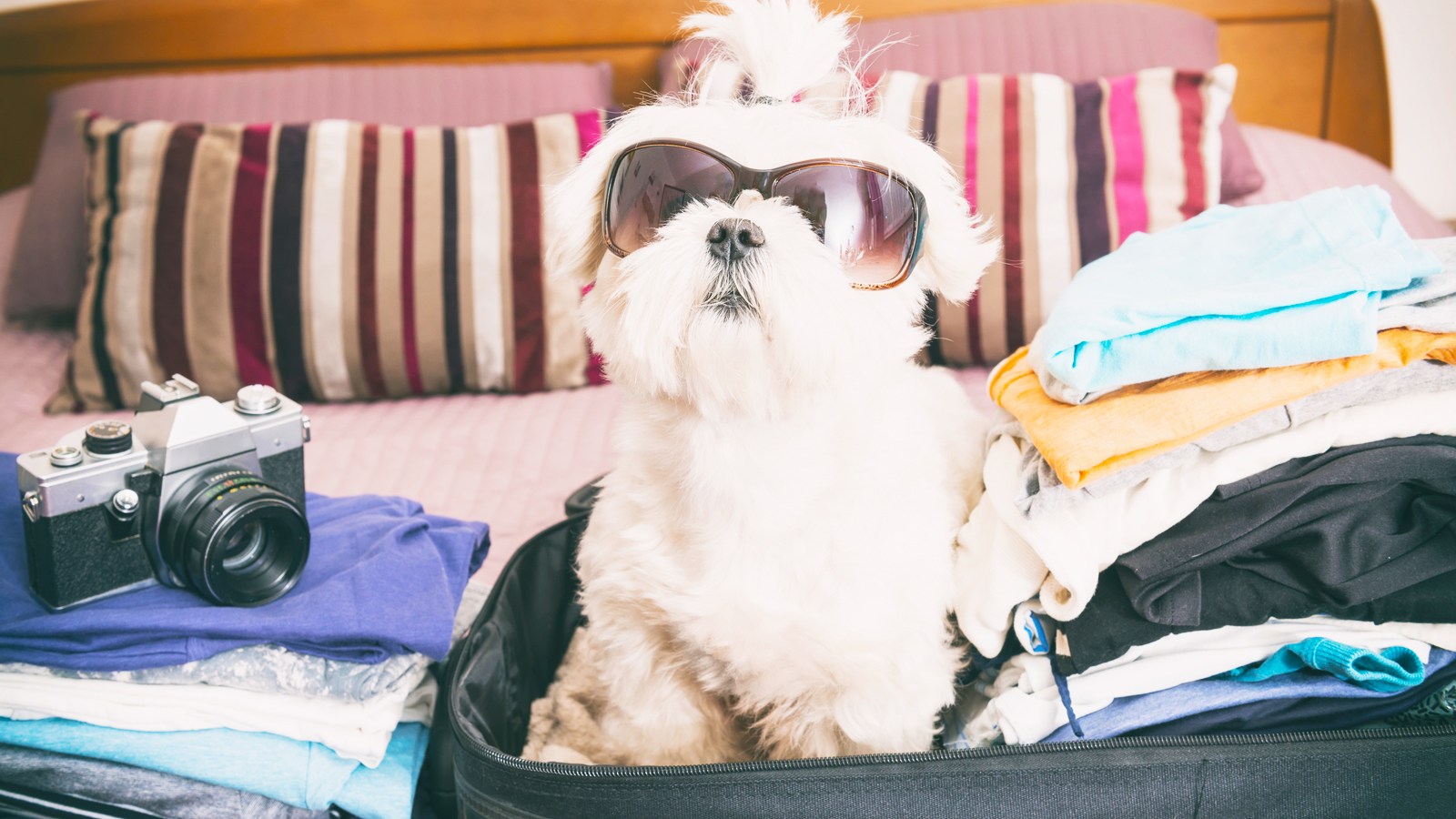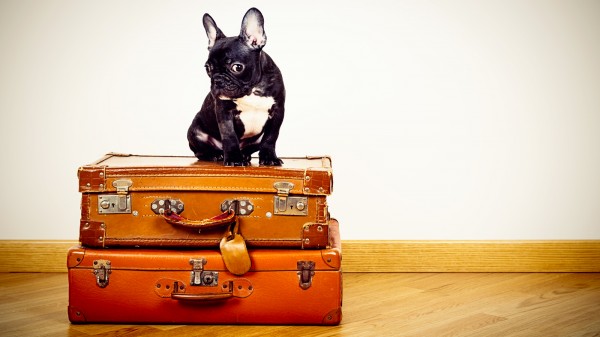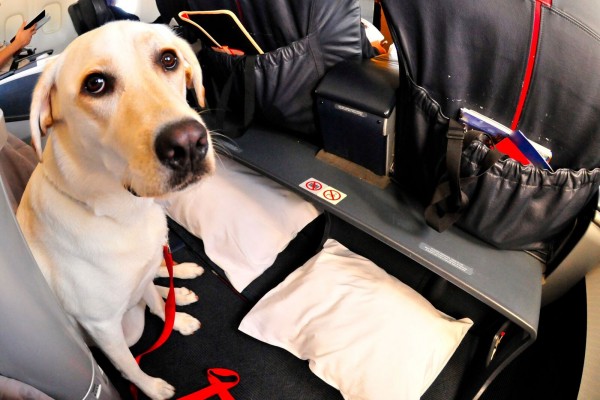Want to know the quickest way to move your pet(s) to Hawaii? The quickest way to get your furry loved ones to the islands is through Direct Airport Release and then the 5 Day-or-Less program. Both processes have the same requirements. As long as you follow all of the State of Hawaii’s rules and guidelines, you should be able to spend only 5 days or less apart from your pet. If your pet doesn’t have the required vaccines, paperwork, etc., they may have to undergo the full 120-day quarantine.
It’s possible to be on the same flight to Hawaii as your pet – and then take them home with you when you leave the airport!
Below is our version of the 5 Day-or-Less program checklist for dogs and cats. We’ve tried to make the process of moving your pet to Hawaii as easy to understand as possible, providing helpful tips and answers to frequently asked questions in addition to the required steps for the 5 Day-or-Less program. Hawaii Life agents also provide useful information about the 5 Day-or-Less program and PCS’ing to Hawaii with pets in previous blog posts.
Steps For Moving Your Pet to Hawaii
It is recommended that you start completing requirements for this checklist about 6-7 months before you plan to arrive in Hawaii.
- Step 1: Rabies Vaccinations
- Step 2: Working Microchip
- Step 3: OIE-FAVN Rabies Blood Test
- Step 4: Waiting Period
- Step 5: Documents
- Step 6: Submission of Documents
- Step 7: Pet Pick-Up
Step 1: Rabies Vaccinations
(Recommended this gets completed 27 weeks prior to move if 2 shots are needed.)
Make sure your pet has up-to-date vaccinations. Pets must have 2 rabies shots given at least 30 days apart (which works out to at least 31 days apart). The most recent one must be done no less than 90 days before the pet’s arrival to Hawaii. Make sure your pet has waited the full 90 days before moving to Hawaii, or your pet will be quarantined until 90 days have passed.
On your pet’s vaccination & health certificate you must include:
- Most recent vaccination date
- Previous vaccination date
- Vaccine type (1-year, 3-year, or 4-year)
Print the Pet Health Certificate Form & Checklist to give to your veterinarian so they can prepare your pet’s health certificate.
—
Step 2: Working Microchip
(Must be completed before the OIE-FAVN rabies blood test – Recommended you schedule this to be done at the time of the second rabies vaccination.)
Microchips are required for all animals moving to Hawaii. Used for identification, it must match the animal’s blood sample. The microchip is about the size of a grain of rice, can be implanted without the pet having to undergo anesthesia, and the implantation procedure doesn’t seem to bother most pets. It is placed between the shoulder blades of the animal.
Regardless of if your pet is getting a microchip for the first time, or if they already have one, make sure the chip has been scanned by a vet and that it is working properly. If the microchip isn’t working, or can’t identify your pet, your pet will have to complete the full 120-day quarantine.
Also, make sure you write down the correct microchip number for your own records and that the correct number is included on your pet’s health certificate.
Note: If you are importing an animal to Hawaii from a foreign country, you can request an electronic microchip. A fee of $27 will be charged for each microchip requested.
—
Step 3: OIE-FAVN Rabies Blood Test
(A passing test – a result greater than or equal to 0.5 IU/ml – is only valid for 36 months – Recommended this gets done 20 weeks before you arrive in Hawaii.)
There are 3 things you need to do for this step:
1. Choose a Lab
Before you bring your pet to the vet for OIE-FAVN testing, you need to decide which lab you will be using. There are two approved labs:
- Kansas State University (KSU)
- Department of Defense Food Analysis and Diagnostic Laboratory in Texas (DOD)
Most people use the KSU lab, but beneficiaries who are authorized treatment at DOD medical treatment facilities are authorized services. If you have the option of using the DOD lab, it will save you some money and maybe even a little time.
2. Visit Your Vet
After your pet receives its second rabies vaccination, wait at least 3 weeks before taking your pet back to the veterinarian to have a blood sample taken for the OIE-FAVN test. (Waiting at least 21 days will give your pet’s body enough time to develop antibodies in response to the vaccination, giving your pet a higher chance that they will pass this test.) The blood sample will be tested to make sure your pet does not have rabies.
Many vets are familiar with the OIE-FAVN test; however, some would like to review the requirements. To speed up the process, it is recommended that you provide your vet with the information prior to your appointment.
Moving to Hawaii isn’t for the faint of heart!
Below is additional information for you and your vet (we recommend you print these and bring them with you to your appointment with your vet):
- DOD OIE-FAVN Submission Requirements & Pricing
- DOD FAVN Testing Request Form
- DOD Testing Instructions
- DOD FAVN Testing Credit Card Authorization Form
Make sure your veterinarian lists “Hawaii” as the destination on the OIE-FAVN blood test submission form. The day after the KCU or DOD receives your pet’s blood sample must be not more than 36 months, and not less than 4 months (120 days), before the date of arrival in Hawaii. Results are valid for three years.
Make sure you pay attention to:
- The date the sample is received by KSU or the DOD lab
- Planned date of arrival in Hawaii (must be at least 120 days after lab receives sample)
3. Check the Results
A passing test is a result greater than or equal to 0.5 IU/ml. The results will automatically be sent to your veterinarian and to Hawaii by KCU or DOD. Call your vet to find out if your pet’s blood test was successful – it usually takes between 3-5 weeks – but could possibly take longer.
Be sure you keep a copy of the passing blood test results with the correct microchip number from your vet. Check your pet’s blood test results for the 5 Day-or-Less program at the Hawaii Department of Agriculture website. You must know your pet’s microchip number (no spaces, dashes, periods, etc.) to get the results. This will let you know the exact date your pet is qualified to enter the state of Hawaii and qualify for Direct Release with no quarantine needed.
Note: If you have a service or guide dog, the OIE-FAVN rabies blood test must be done after the animal is 12 months or 1 year of age. For all other animals, there is no age requirement for this blood test.
—
Step 4: Waiting Period
(At least 120 days or 16 weeks.)
Make sure you have everything in place before planning to move your pet. Your pet must wait 120 days (4 months) from the date the laboratory receives the blood sample before they can arrive in Hawaii. Why not have them wait at home? Early arrival in Hawaii means your pet will not qualify for the 5 Day-or-Less program or Direct Airport Release, and fees apply for each day your pet is kept ($14.30/day).
If your pet is going to undergo the full 120-day quarantine, you must select an approved Hawaii veterinary hospital for your pet and include it on the Dog & Cat Import Form.
We have to wait for how long?!
—
Step 5: Documents
(A total of 4-7 original documents required – more documents required if your final destination is to a neighbor island – 1 document required to be done within 14 days of arrival.)
Original documents are required. To make the experience easier, be sure you have 2-3 copies of each. Required documents include:
1. Two (2) rabies vaccination certificates that include:
- vaccine name
- lot or serial number
- booster interval
- vaccination date
- vaccine lot expiration date
2. An original health certificate* (in English) including:
- necessary rabies vaccination information
- rabies vaccine name
- lot or serial number
- booster interval
- vaccination date
- expiration date
- microchip number
- veterinary identifying information (must have vet’s signature in ink)
- animal identifying information (breed, color, sex, etc.)
- animal was treated with fipronil or equivalent product within 14 days of arrival (Revolution brand not acceptable); List product and date animal was treated.
*The health certificate and parasite treatment must be done within 14 days of arrival. You do not need to mail in the health certificate, due to time restraints.
3. Dog & Cat Import Form. This form must be notarized and you will need one form for each pet you want to bring.
4. Neighbor Island Inspection Permit. If your final destination is to a neighbor island, you must have an inspection permit for that island. You must submit the required documentation 30 days or more before arrival.
Documentation includes:
- Original rabies vaccination certificates (2 total)
- Dog & Cat Import Form (must be notarized)
- $145 money order or cashier’s check (Payable to: Dept. of Agriculture)
- A letter from the owner requesting Direct Airport Release at the desired destination (Kona, Kahului, or Lihue)
- Flight information (airlines, flight number, arrival date and time). It’s recommended that you print out your itinerary and mail that in with the rest of the required documents.
Owners must make reservations for inspection with:
Kona Airport (Big Island)
- Kona Veterinary Service: (808) 325-6637
- Keauhou Veterinary Hospital: (808) 322-2988
Kahului Airport (Maui)
- Central Maui Animal Clinic: (808) 893-2380
- Maui Humane Society: (808) 877-3680
- South Shore Veterinary Care: (808) 874-3422
Lihue Airport (Kauai)
- Kauai Humane Society: (808) 632-0610
The original Neighbor Island Inspection Permit must be with your pet on the aircraft and be given to the inspector upon arrival in Hawaii.
Note: Contractors will confirm with the Animal Quarantine Station that they have agreed to perform the inspection and release procedure. Additional fees may apply for this service.
—
Step 6: Submission of Documents
(Send all documents & fees in together – Recommended that you mail everything in as a set 30 days before arrival.)
If your final destination is Oahu, send all documents and fees to the Animal Quarantine Station as a set at least 10 days before you arrive in Hawaii (see address below). If you are requesting a Direct Airport Release on a neighbor island, you must mail in the necessary documentation to the Animal Quarantine Station 30 days or more before your arrival. Only the original health certificate and the Neighbor Island Inspection Permit should arrive with your pet.
Before mailing your original documents in, make sure you make 2-3 copies of each to bring with you and to keep for your records. It is recommended that you send your documents by mail with return receipt to verify delivery, or by an overnight carrier that provides tracking of your documents.
What to mail (4-7 documents):
- Dog & Cat Import Form (must be notarized)
- 2 rabies vaccination certificates (w/actual veterinarian signature in ink)
- Payment ($165 for Direct Release/$224 for 5 Day-or-Less/$145 for Neighbor Island Inspection Permit)
- Neighbor Island Inspection Permit documentation (do not mail the actual permit; that will need to arrive with your pet)
Note: Payments must be a cashier’s check or money order, no personal checks. Make sure to include your pet’s microchip number with payment. Payable to: Department of Agriculture.
Mail to:
Animal Quarantine Station
99-951 Halawa Valley Street,
Aiea, Hawaii 96701
—
Step 7: Pet Pick-Up
(Make sure you have a cart or some way to carry your pet’s kennel – pets must remain in kennel on airport property.)
Direct Airport Release
Pets will only be released to the consignee identified on the shipmaster’s declaration, or those listed on a notarized Dog and Cat Import Form (AQS 278). If you will be using an authorized handler, or somebody besides you will be picking up your pet, be sure to include their information on the Dog & Cat Import Form and have them bring proper picture identification.
Ready to go home after a long flight!
Direct Airport Releases are primarily done at the Honolulu International Airport on Oahu, but also done on the neighbor islands of the Big Island, Maui, and Kauai. If your final destination is on another island, be sure to use their Direct Release program to ensure the quickest release possible.
- For Big Island, use the Kona Airport
- For Maui, use the Kahului Airport
- For Kauai, use the Lihue Airport
For Oahu, you must arrange for your pet to arrive at the Airport Animal Quarantine Holding Facility at the Honolulu International Airport during normal inspection hours between 8:00 AM to 5:00 PM (daily, including weekends and holidays.) Make sure that you are on a flight that arrives in Honolulu by 3:00 PM if you plan on taking your pet home that day. (It could take an hour or more for your pet to be transferred from the airplane. Pets arriving after 4:30 will be available for pick up the following day during normal business hours.)
For all islands, pets that do not arrive during normal business hours will not be qualified for Direct Release at the airport; instead, they will be released to an approved holding facility. For Oahu, your pet would be taken to Halawa Valley the following morning, kept at the Animal Quarantine Station (see address below), and put in the 5 Day-or-Less program ($224/pet fee).
If your pet will be flying on an international flight, they will need to clear Customs before they are released by the AAQHF. Make sure you check the U.S. Customs’ business hours to ensure your pet will be arriving at a good day/time (ask your airline for that information).
Reminders:
- Make sure your airline participates in the Direct Release program for your desired island.
- Make sure you arrange for a local inspector to be available at the time of your pet’s arrival.
- Make sure you have your pet’s health certificate and the Neighbor Island Inspection Permit (if applicable) upon arrival to give to the inspector.
First stop: The beach!
5 Day-or-Less Pets
Unless you make arrangements beforehand with the Airport Animal Quarantine Holding Facility, pets in the 5 Day-or-Less program will be brought to the Animal Quarantine Station in Halawa Valley, or approved holding facility on the neighbor islands, and are available to pick up after all documents are received and verified.
Any animal prepared for the 5 Day-or-Less program is eligible for Direct Release after paying a $165 fee. It is important to know, however, that once the airport releases a pet they can no longer take the pet back, even if the owner has no place to go or take it.
If you have to spend a couple of days in a hotel that doesn’t allow pets, you may want to consider letting your pet stay at the Animal Quarantine Station, or holding facility, for a few days. It is a $224 flat rate fee for an animal that stays 5 days at the AQS. Fees for any additional days will be $18.70/day.
Note: You must arrange for your pet to be picked up from the airport and transported off the property. Your pet must remain in its kennel until it is completely off of airport property. This means if you have a large animal, or multiple animals, you must have a vehicle that is large enough to hold the pet(s) in its kennel.
Note: If you will not be able to pick up your pet upon their arrival, there are several registered intermediate handlers that can help with that.







Alan Ogden
May 14, 2017
Lots of info. It would be very helpful to create a typical timeline for persons wanting to ship pets to Hawaii. I.e.
1. First step, at least x months/days before arriving
2. Next, at least x months/days before arriving
Devin Newmeyer
July 28, 2017
Great helpful article! Thanks! I am moving from NYC to Hawaii next April with my dog and have been so confused by all of the information available. Yours really breaks it down. I just have a couple of questions for you:
1- as far as rabies shots, if my dog has been getting regular shots every year (she is getting her yearly one in August), would she need another on top of that? I”m a little confused on that.
2- we will be flying with our dog to Hawaii. When we get there, we actually have to arrange to get the dog to the animal quarantine station or they will immediately take her there and we have to go pick her up with the paperwork? I’m a little unclear on this.
This has been so helpful! Thank you again!
Devin
T A Niles
December 26, 2017
Awesome job! Really glad I found this. So very informative!
NILES D HANSEN
April 10, 2018
A specific time line would be easier to follow. I appreciate all of the information, though it’s a bit convoluted… especially since the 3 different options are combined in the same body of work. Maybe break it down into 3 defined lists? Thanks!
Marina M
August 24, 2018
Anyone else think this whole process is B.S.? Especially when no animal – out of the thousands that come every year – has ever come to a Hawaii quarantine facility with rabies, meaning no outbreak has ever been prevented in 90 years. Hawaii spends $2M a year on its facilities. Wasteful if you ask me.
Btw, you have to get the FAVN 10-21 days after the second rabies shot. My vet made me wait 14 days. After 21 days is no good, pet will probably fail. Important since vets charge nearly $400 or more for the FAVN regardless of a fail. Even though the lab charges vets $90 for it. I find the FAVN to be highly unnecessary, it doesn’t confirm or deny the presence of rabies but just the animal’s response to it which will be weaker unless they recently and repeatedly had the rabies vaccination. Seems to be more of a confirmation of vaccines. Plus it doesn’t work well with elderly or animals with a lower immune system, coincidentally the type that is most at risk of death if put into the quarantine facility. You don’t get a refund if your pet dies there.
I cannot stress enough that the quarantine facility should be avoided at all costs, not only is it stressful and an unpleasant experience for your animal but there are many hidden fees in addition to the daily rate. No number has been released on how many have died there, but plenty of stories online to avoid it altogether.
Lauren Tamonte
July 1, 2022
OMG!!! It’s all a bit much! It’s very overwhelming and overkill. Seem so unnecessary and It’s animal abuse. So ridiculous what the owner and pet have to go through as well as all the time and money. Discouraging!!!
Wilma Bodrak
May 12, 2019
We have one dog that is allergic to the rabies vaccine! What can we do? Plus we would be coming from Mexico and have no way to get the blood samples to the listed testing sites in a timely manner. Is this going to be impossible to bring our 2 dogs and fat cat with us?
Tyler
July 21, 2020
Wanted to let you know this info is slightly misleading.. there’s no longer a gap requiring a 4 month delay after the FAVN shot. Double-checked the .gov site and on there they only state that thirty days must have passed to be permitted through the DAR/5-day programs.